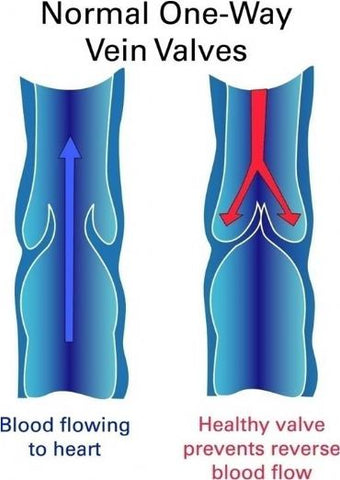Keep Your Legs Healthy With Good Circulation
Share
Our legs get a lot of attention in terms of appearance. However, they don't often get the proper amount of attention in terms of their health. Most of us know that our heart pumps blood to and from our entire body, but did you know that there is a blood pump in your legs as well? In your legs there are veins. Within these veins there are valves that work to push the blood in your legs back up to be pumped through the heart. Due to gravity, the blood in our body travels downward when we are in an upright position. For that matter, these valves in our legs are one-way valves. This means that healthy valves only allow blood to flow in one direction. Since there is a gravitational force already pushing our blood down, these one-way valves must work to help the blood flow back in the opposite direction (up) and at the same time prohibit the blood from continuing to flow down in the legs. The way they prevent blood from flowing continuously downward is by closure of the valve. With a closed valve, the blood has nowhere to go but up. When conditions or situations occur that prevent these valves from functioning properly, blood is able to flow in either direction and can cause a clot or pooling of blood in the legs.

These valves in your legs function by being squeezed by the calf muscles surrounding it. Your calf muscles are put to work each time you do a physical activity involving your legs, such as walking or running. Sitting or standing for long periods of time prevents the calf muscles from moving, thus preventing the valves in your legs from pumping blood back upward. For these long periods of inactivity, try these simple leg exercises to help maintain the circulation in your legs.
Why should you be so concerned about leg circulation?
Many people are unaware of the dangers long periods of inactivity can lead to. With the valves in your legs being either inactive or dysfunctional, pooling of blood in the veins will likely lead to venous insufficiency conditions such as varicose veins. At first glance, varicose veins will look like bulgy, squiggly lines traveling along your legs. However, it can get to the point of the varicose veins becoming very achy and your legs feeling fatigued. A more severe condition that can occur due to inactivity or dysfunctional valves is a Deep Vein Thrombosis (DVT), or a blood clot, developing in your legs. DVTs need to be taken very seriously due to the serious complications they can lead to if they manage to flow up into the lungs or other major organs. Swelling in the ankles may also occur due to the pressure build up of pooling blood. If left untreated, redness may appear around the upper ankle area and possibly develop into a venous ulcer.
What are the risk factors?
In order to take good care of your legs it is important to be aware of the risk factors involved. We've already discussed that exercising and moving your legs is the key way to keeping your legs well circulated. In this regard, having a sedentary job or lifestyle can you put at risk for developing venous disease. Similarly, long periods of travel involving constricting of movement (e.g., plane rides, sitting in a vehicle for too long, etc.) also prevent healthy leg circulation and are a silent danger unknown to many people. Surgical procedures and major injuries are DVT risk factors. Damage to vein walls or immobility during recovery following a surgery can lead to a blood clot. To name a few, constrictions of movement and surgical procedures or injuries to the body prevent healthy blood flow within the vein walls and valves of the vascular system.
What can you do to keep your legs healthy?
First and foremost, exercise is a great way to keep your legs strong and healthy. Exercise will keep your legs feeling healthy and your calf muscles working. Not enough people are aware of them, but graduated compression stockings are a great preventative or aid in treatment for venous insufficiency. Compression stockings work to keep your valves functioning by putting a comfortable amount of external pressure on the legs and squeezing the valves just enough to keep them working properly. They are ideal for individuals with damage to their leg valves or for long periods of sitting or standing. If you have a sedentary job or if there is a time in which you will be sitting or standing for a long period of time, keep in mind those 10 basic leg exercises to keep your blood circulating. Also, be aware and do something about it. Be aware of the risk factors and know what symptoms to look out for. If you're going to be in a situation that may be a risk factor, be prepared for it. If you're going to be going on a plane ride of four hours or longer, get a pair of compression stockings. If you notice varicose veins appearing on your legs, don't wait for them to get achy. If you're going on a road trip, do the leg exercises for healthy circulation. Keep your legs healthy and happy by keeping the blood flow circulating well. Your legs work hard for you, so be sure to take care of them!



